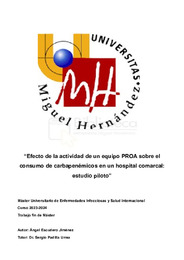Por favor, use este identificador para citar o enlazar este ítem:
https://hdl.handle.net/11000/35824
Efecto de la actividad de un equipo PROA sobre el consumo de carbapenémicos en un hospital comarcal:
estudio piloto
Título :
Efecto de la actividad de un equipo PROA sobre el consumo de carbapenémicos en un hospital comarcal:
estudio piloto |
Autor :
Escudero Jimémez, Ángel |
Tutor:
Padilla, Sergio  |
Editor :
Universidad Miguel Hernández |
Departamento:
Departamentos de la UMH::Medicina Clínica |
Fecha de publicación:
2024-09-02 |
URI :
https://hdl.handle.net/11000/35824 |
Resumen :
Fundamento y objetivos: La resistencia a antibióticos es una emergencia sanitaria de
nivel internacional. Como consecuencia del elevado uso de carbapenémicos se ha
producido la aparición y dispersión de enterobacterias productoras de carbapenemasas,
limitando así el abordaje terapéutico cuando éstas ocasionan algún tipo de infección. La
constitución de equipos PROA constituye uno de los niveles de actuación dentro del
marco del plan de resistencia antimicrobiana nacional. El objetivo es evaluar el efecto de
la actividad del equipo PROA hospitalario durante su primer año de funcionamiento sobre
la optimización del uso de carbapenémicos. Material y métodos: Estudio retrospectivo antes-después del inicio de la actividad del
equipo PROA con registro prospectivo de las intervenciones realizadas mediante
asesorías de prescripción no impositivas en pacientes ingresados en el hospital de Hellín.
Se midieron los siguientes indicadores: consumo de antimicrobianos (DDD1000E y
DDT1000E) y prevalencia de resistencia antibiótica a carbapenémicos para Acinetobacter
baumanii, Pseudomonas aeruginosa y enterobacterias (Escherichia coli, Klebsiella
pneumoniae) y enterobacterias resistentes a cefalosporinas de 3ª generación. Se realizó
un análisis comparativo de los indicadores durante el periodo de estudio (2018 – 2023). Resultados: Los estudios comparativos para ambos indicadores de consumo de
carbapenémicos (DDD1000E y DDT1000E) muestran diferencias significas entre ambas
fases del mismo, con una tendencia a lo largo del periodo de estudio. Se encontraron
diferencias significativas (p<0,05) en DDD1000E entre el periodo 2018-2019 y los años
2021, 2022 y 2023 y también en las DDT1000E (p < 0,001), de forma que el año 2023 ha
presentado valores inferiores al resto de años excepto el año 2021.Se aceptaron el 84,4%
de las propuestas realizadas sobre tratamientos que incluían un carbapenémicos. La implantación de un programa de asesorías no impositivas puede contribuir a reducir el consumo de carbapenémicos con una buena aceptación entre los clínicos.
Background and aim: Antibiotic resistance is a health emergency for all international
health agencies. The emergence and spread of carbapenemase-producing
enterobacterales as a consequence of the high use of carbapenems limits the therapeutic
approach to infections caused by these. Antimicriboal stewardship teams (AST) formation
is one of the action levels within the framework of the national antimicrobial resistance
plan. The objetiv is to evaluate the AST activity effect for optimizing carbapenem use
during its first year. Materials and methods: Retrospective study after-before AST activity starts with
counselling interventions carried out through non-restrictive advice about antibiotic
treatment at the regional hospital of Hellín. Measure indicators were: antimicrobial
consumption (DDD1000E and DDT1000E) and prevalence antibiotic resistence to
carbapenems for Acinetobacter baumanii, Pseudomonas aeruginosa and enterobacterales
(Escherichia coli, Klebsiella pneumoniae) and 3rd generation cephalosporins resistance
for enterobacterales (Escherichia coli, Klebsiella pneumoniae). A comparative statistical
analysis was carried during the study period (2018 – 2023). Results: Carbapenem consumption indicators (DDD1000E and DDT1000E) show
significant differences throughout the study period with a downward trend. There are
significant differences (p < 0,05) for DDD1000E comparisons between 2018-2019 period
before AST activity and 2021, 2022 and 2023 year. There are significant differences (p <
0,001) for DDT1000E comparisons in witch 2023 presented lower values than rest of the
years, except for 2021. A total of 84,4% carbapenem treatment AST counselling were
accepted. Conclusion: A non-mandatory counselling program implementation can help to reduce
carbapenem consume with good clinical acceptance.
|
Palabras clave/Materias:
antimicrobial stewardship program
carbapenem
antimicrobial resistance
hospital infections
process measures |
Área de conocimiento :
CDU: Ciencias aplicadas: Medicina: Patología. Medicina clínica. Oncología |
Tipo de documento :
info:eu-repo/semantics/masterThesis |
Derechos de acceso:
info:eu-repo/semantics/openAccess
Attribution-NonCommercial-NoDerivatives 4.0 Internacional |
Aparece en las colecciones:
TFM-M.U Enfermedades Infecciosas y Salud Internacional
|
 La licencia se describe como: Atribución-NonComercial-NoDerivada 4.0 Internacional.
La licencia se describe como: Atribución-NonComercial-NoDerivada 4.0 Internacional.
 La licencia se describe como: Atribución-NonComercial-NoDerivada 4.0 Internacional.
La licencia se describe como: Atribución-NonComercial-NoDerivada 4.0 Internacional.
.png)
